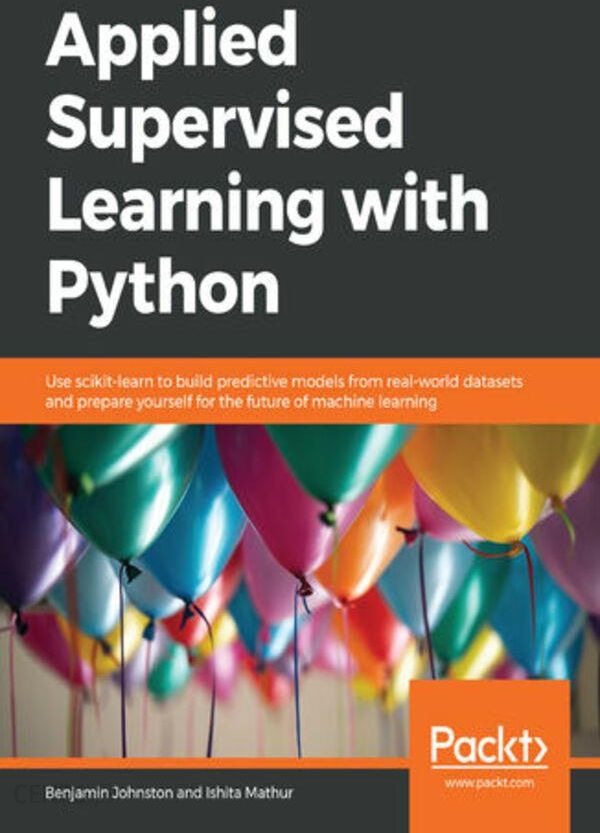Description
Explore the exciting world of machine learning with the fastest growing technology in the world Key Features Understand various machine learning concepts with real-world examples Implement a supervised machine learning pipeline from data ingestion to validation Gain insights into how you can use machine learning in everyday life Book Description Machine learning—the ability of a machine to give right answers based on input data—has revolutionized the way we do business. Applied Supervised Learning with Python provides a rich understanding of how you can apply machine learning techniques in your data science projects using Python. Youll explore Jupyter Notebooks, the technology used commonly in academic and commercial circles with in-line code running support. With the help of fun examples, youll gain experience working on the Python machine learning toolkit—from performing basic data cleaning and processing to working with a range of regression and classification algorithms. Once youve grasped the basics, youll learn how to build and train your own models using advanced techniques such as decision trees, ensemble modeling, validation, and error metrics. Youll also learn data visualization techniques using powerful Python libraries such as Matplotlib and Seaborn. This book also covers ensemble modeling and random forest classifiers along with other methods for combining results from multiple models, and concludes by delving into cross-validation to test your algorithm and check how well the model works on unseen data. By the end of this book, youll be equipped to not only work with machine learning algorithms, but also be able to create some of your own! What you will learn Understand the concept of supervised learning and its applications Implement common supervised learning algorithms using machine learning Python libraries Validate models using the k-fold technique Build your models with decision trees to get results effortlessly Use ensemble modeling techniques to improve the performance of your model Apply a variety of metrics to compare machine learning models Who this book is for Applied Supervised Learning with Python is for you if you want to gain a solid understanding of machine learning using Python. Itll help if you to have some experience in any functional or object-oriented language and a basic understanding of Python libraries and expressions, such as arrays and dictionaries. Spis treści:PrefaceAbout the BookAbout the AuthorsObjectivesAudienceApproachHardware RequirementsSoftware RequirementsConventionsInstallation and SetupInstalling the Code BundleAdditional ResourcesChapter 1Python Machine Learning ToolkitIntroductionSupervised Machine LearningWhen to Use Supervised LearningWhy Python?Jupyter NotebooksExercise 1: Launching a Jupyter NotebookExercise 2: Hello WorldExercise 3: Order of Execution in a Jupyter NotebookExercise 4: Advantages of Jupyter NotebooksPython Packages and ModulespandasLoading Data in pandasExercise 5: Loading and Summarizing the Titanic DatasetExercise 6: Indexing and Selecting DataExercise 7: Advanced Indexing and Selectionpandas MethodsExercise 8: Splitting, Applying, and Combining Data SourcesLambda FunctionsExercise 9: Lambda FunctionsData Quality ConsiderationsManaging Missing DataClass ImbalanceLow Sample SizeActivity 1: pandas FunctionsSummaryChapter 2Exploratory Data Analysis and VisualizationIntroductionExploratory Data Analysis (EDA)Exercise 10: Importing Libraries for Data ExplorationSummary Statistics and Central ValuesStandard DeviationPercentilesExercise 11: Summary Statistics of Our DatasetMissing ValuesFinding Missing ValuesExercise 12: Visualizing Missing ValuesImputation Strategies for Missing ValuesExercise 13: Imputation Using pandasExercise 14: Imputation Using scikit-learnExercise 15: Imputation Using Inferred ValuesActivity 2: Summary Statistics and Missing ValuesDistribution of ValuesTarget VariableExercise 16: Plotting a Bar ChartCategorical DataExercise 17: Datatypes for Categorical VariablesExercise 18: Calculating Category Value CountsExercise 19: Plotting a Pie ChartContinuous DataExercise 20: Plotting a HistogramExercise 21: Skew and KurtosisActivity 3: Visually Representing the Distribution of ValuesRelationships within the DataRelationship between Two Continuous VariablesExercise 22: Plotting a Scatter PlotExercise 23: Correlation HeatmapExercise 24: PairplotRelationship between a Continuous and a Categorical VariableExercise 25: Bar ChartExercise 26: Box PlotRelationship between Two Categorical VariablesExercise 27: Stacked Bar ChartActivity 4: Relationships Within the DataSummaryChapter 3Regression AnalysisIntroductionRegression and Classification ProblemsData, Models, Training, and EvaluationLinear RegressionExercise 28: Plotting Data with a Moving AverageActivity 5: Plotting Data with a Moving AverageLeast Squares MethodThe scikit-learn Model APIExercise 29: Fitting a Linear Model Using the Least Squares MethodActivity 6: Linear Regression Using the Least Squares MethodLinear Regression with Dummy VariablesExercise 30: Introducing Dummy VariablesActivity 7: Dummy VariablesParabolic Model with Linear RegressionExercise 31: Parabolic Models with Linear RegressionActivity 8: Other Model Types with Linear RegressionGeneric Model TrainingGradient DescentExercise 32: Linear Regression with Gradient DescentExercise 33: Optimizing Gradient DescentActivity 9: Gradient DescentMultiple Linear RegressionExercise 34: Multiple Linear RegressionAutoregression ModelsExercise 35: Creating an Autoregression ModelActivity 10: AutoregressorsSummaryChapter 4ClassificationIntroductionLinear Regression as a ClassifierExercise 36: Linear Regression as a ClassifierLogistic RegressionExercise 37: Logistic Regression as a Classifier Two-Class ClassifierExercise 38: Logistic Regression Multiclass ClassifierActivity 11: Linear Regression Classifier Two-Class ClassifierActivity 12: Iris Classification Using Logistic RegressionClassification Using K-Nearest NeighborsExercise 39: K-NN ClassificationExercise 40: Visualizing K-NN BoundariesActivity 13: K-NN Multiclass ClassifierClassification Using Decision TreesExercise 41: ID3 ClassificationExercise 42: Iris Classification Using a CART Decision TreeSummaryChapter 5Ensemble ModelingIntroductionExercise 43: Importing Modules and Preparing the DatasetOverfitting and UnderfittingUnderfittingOverfittingOvercoming the Problem of Underfitting and OverfittingBaggingBootstrappingBootstrap AggregationExercise 44: Using the Bagging ClassifierRandom ForestExercise 45: Building the Ensemble Model Using Random ForestBoostingAdaptive BoostingExercise 46: Adaptive BoostingGradient BoostingExercise 47: GradientBoostingClassifierStackingExercise 48: Building a Stacked ModelActivity 14: Stacking with Standalone and Ensemble AlgorithmsSummaryChapter 6Model EvaluationIntroductionExercise 49: Importing the Modules and Preparing Our DatasetEvaluation MetricsRegressionExercise 50: Regression MetricsClassificationExercise 51: Classification MetricsSplitting the DatasetHold-out DataK-Fold Cross-ValidationSamplingExercise 52: K-Fold Cross-Validation with Stratified SamplingPerformance Improvement TacticsVariation in Train and Test ErrorHyperparameter TuningExercise 53: Hyperparameter Tuning with Random SearchFeature ImportanceExercise 54: Feature Importance Using Random ForestActivity 15: Final Test ProjectSummaryAppendixChapter 1: Python Machine Learning ToolkitActivity 1: pandas FunctionsChapter 2: Exploratory Data Analysis and VisualizationActivity 2: Summary Statistics and Missing ValuesActivity 3: Visually Representing the Distribution of ValuesActivity 4: Relationships Within the DataChapter 3: Regression AnalysisActivity 5: Plotting Data with a Moving AverageActivity 6: Linear Regression Using the Least Squares MethodActivity 7: Dummy VariablesActivity 8: Other Model Types with Linear RegressionActivity 9: Gradient DescentActivity 10: AutoregressorsChapter 4: ClassificationActivity 11: Linear Regression Classifier Two-Class ClassifierActivity 12: Iris Classification Using Logistic RegressionActivity 13: K-NN Multiclass ClassifierChapter 5: Ensemble ModelingActivity 14: Stacking with Standalone and Ensemble AlgorithmsChapter 6: Model EvaluationActivity 15: Final Test Project
E-informatyka
rozlicz podatek, bilet dobowy warszawa, lekarz od kręgosłupa jak się nazywa, choroby brudnych rąk, instrukcje obsługi po polsku, mackiewicz, ordnung, rosja ludność, oscypek kcal, ria novosti, robin thicke i blurred lines, arafat, poprawka, starzy ludzie, dzienna dawka cukru, jak się przemeldować, zwolnienie od psychiatry, 1 wojna światowa, etatyści
yyyyy




![Matematyka z plusem ćwiczenia dla klasy 6 arytmetyka wersja B część 1/2 szkoła podstawowa wydanie 2022 [KSIĄŻKA]](https://armiikrajowej36.pl/wp-content/uploads/2022/10/i-matematyka-z-plusem-cwiczenia-dla-klasy-6-arytmetyka-wersja-b-czesc-1-2-szkola-podstawowa-wydanie-2022-ksiazka-300x300.jpg)